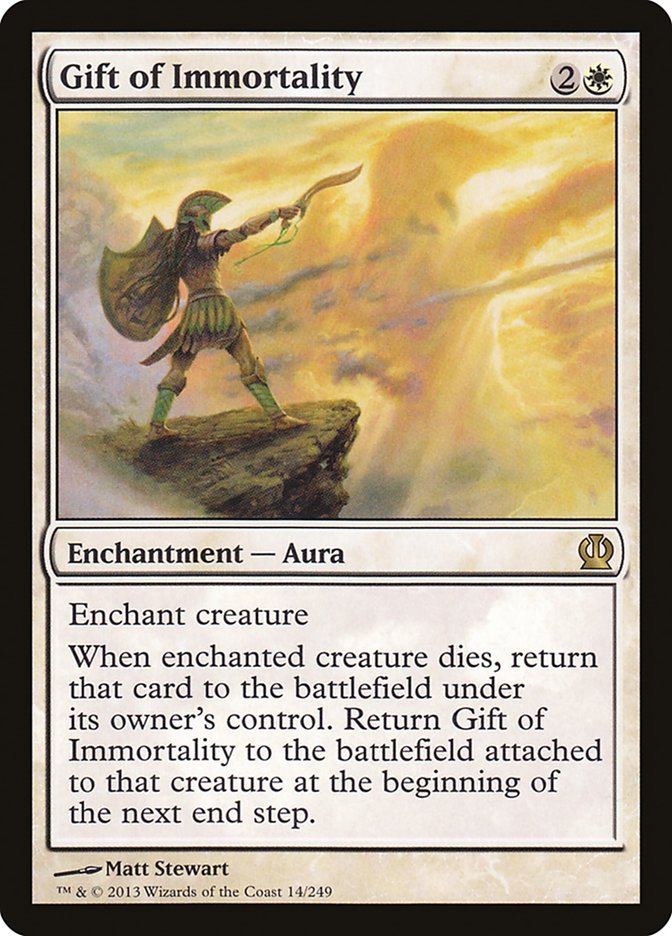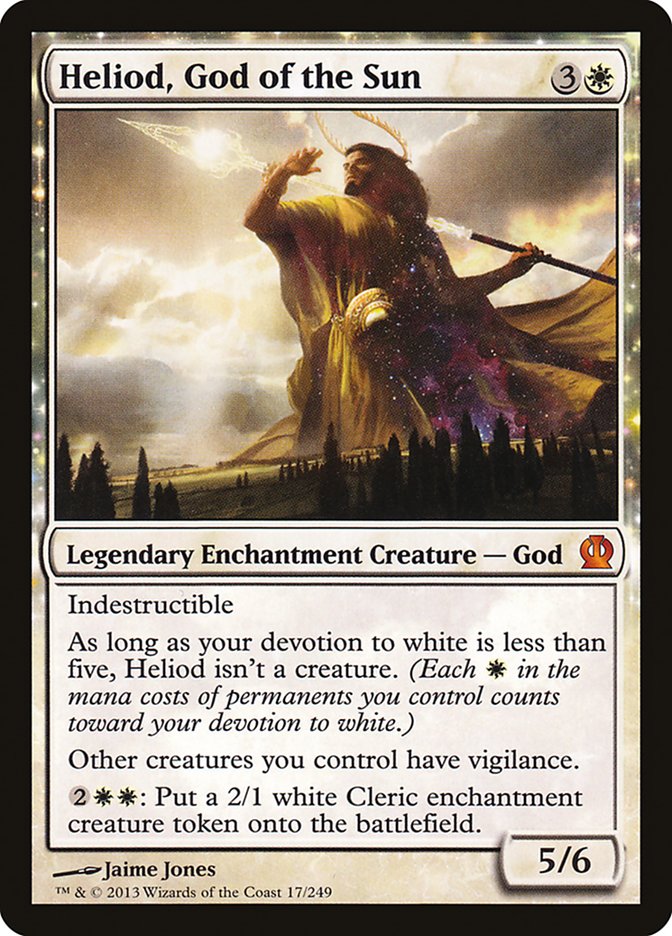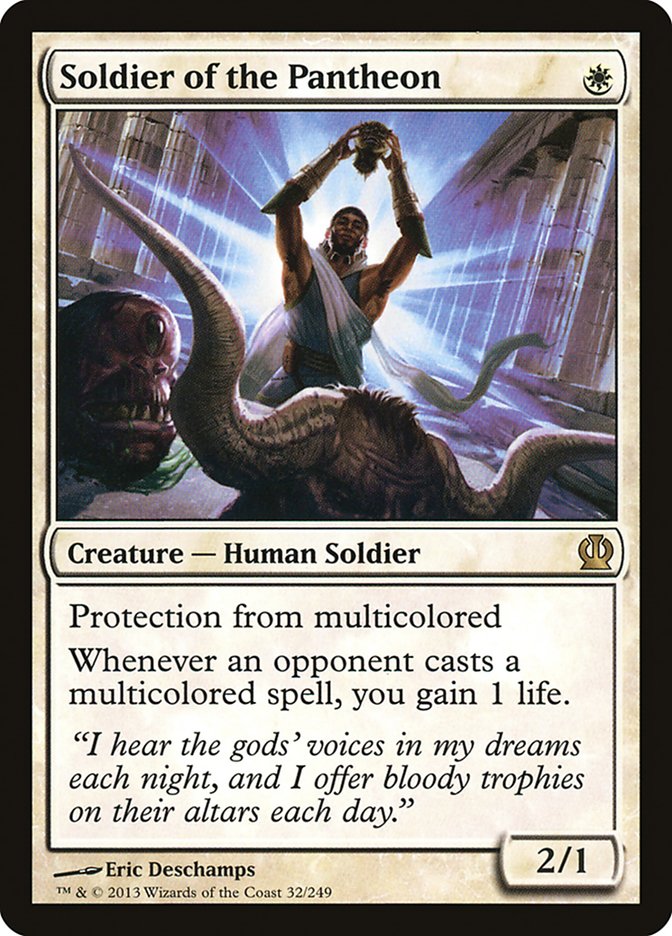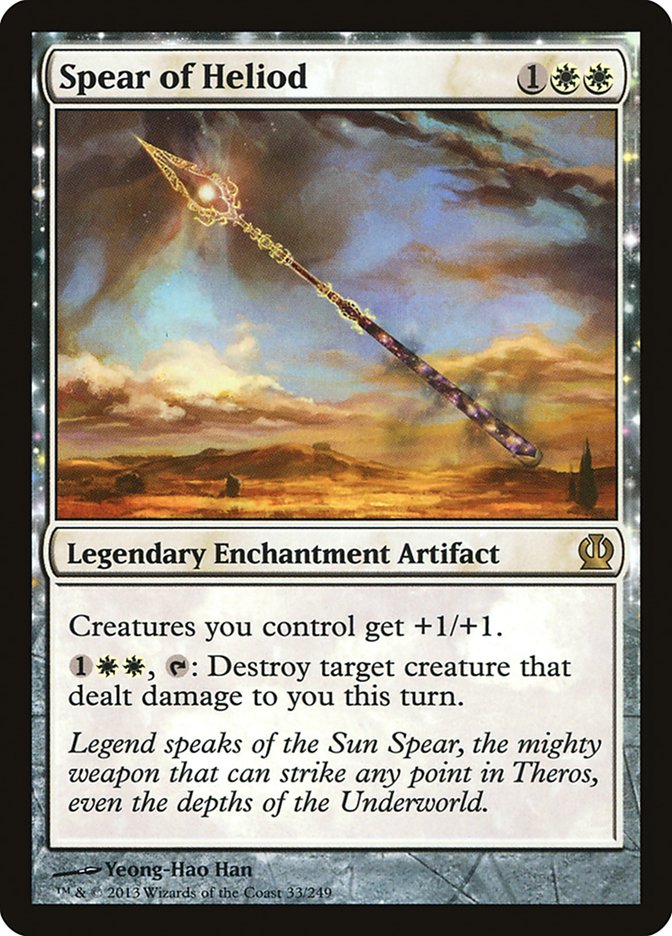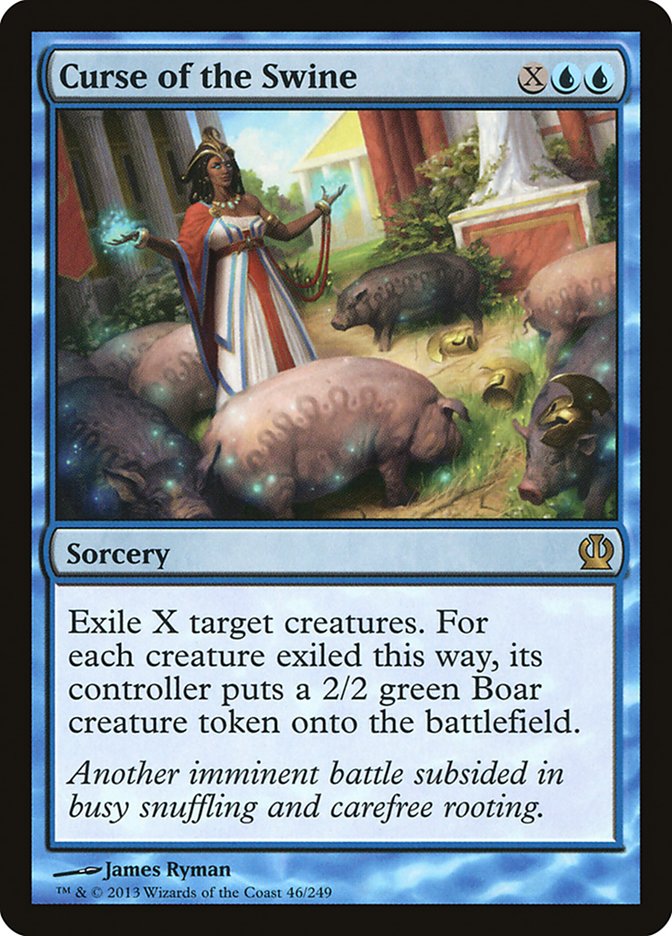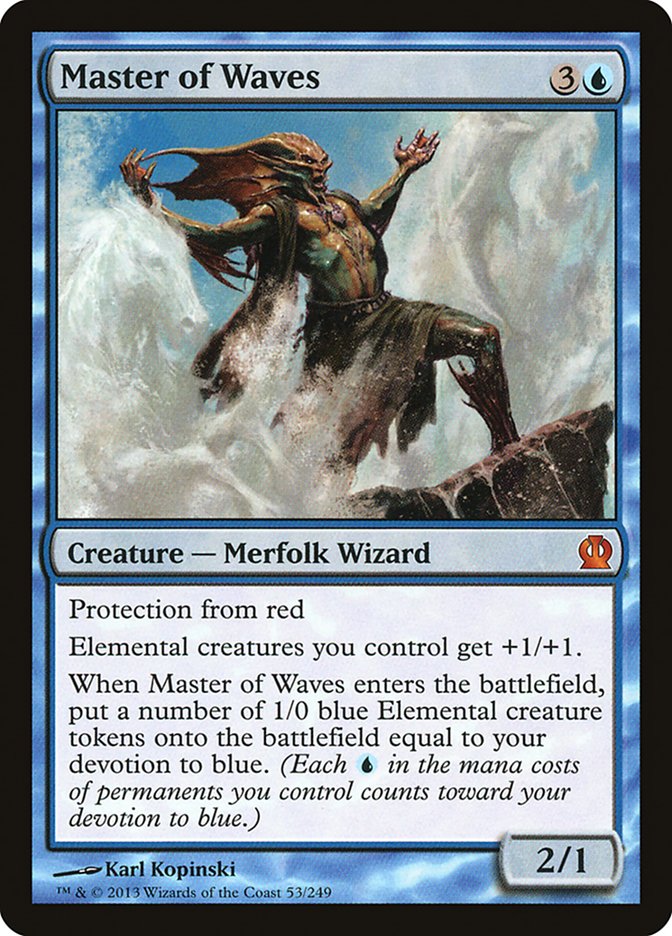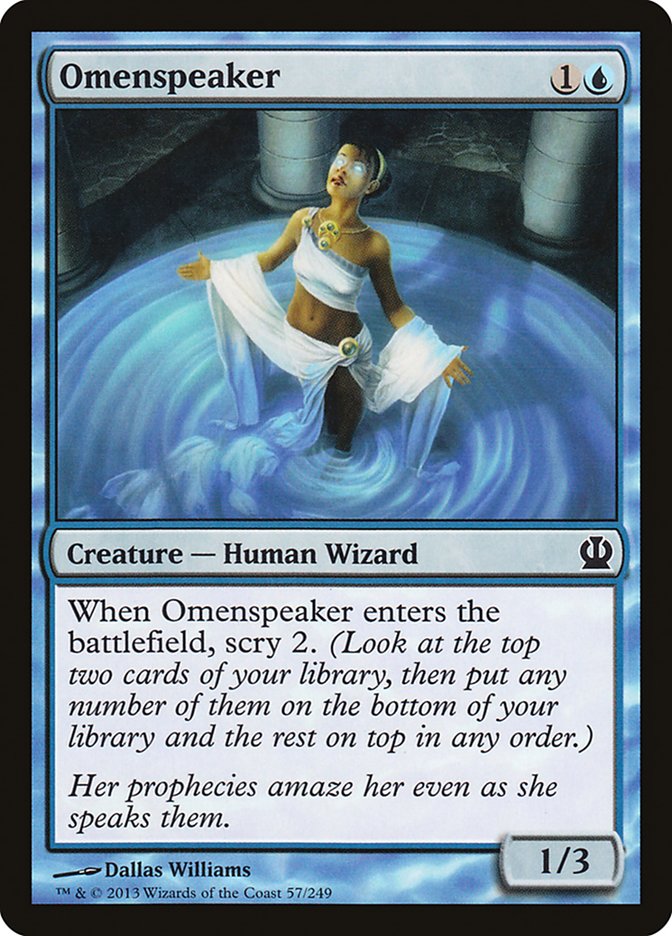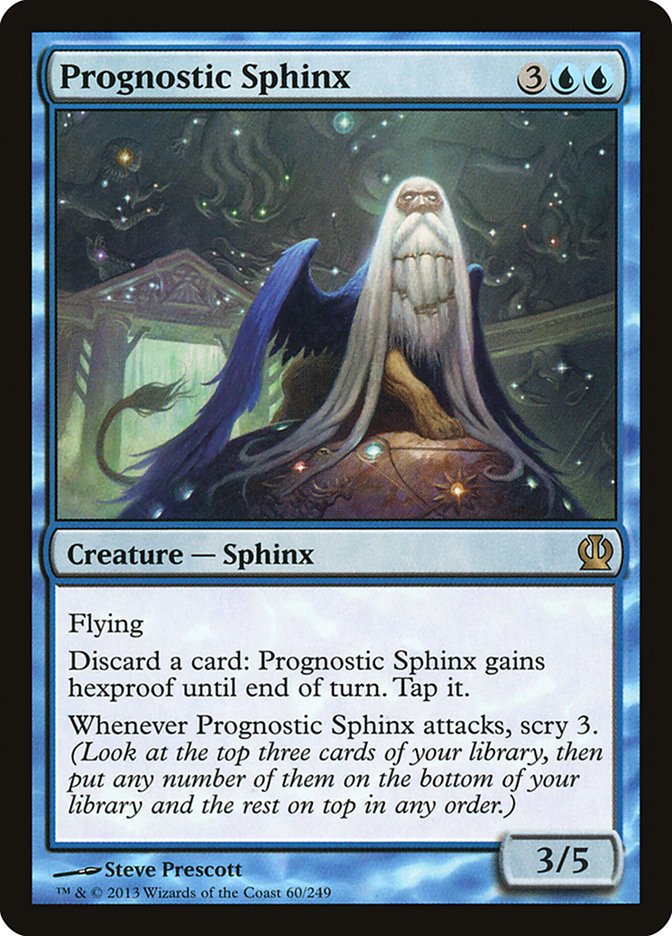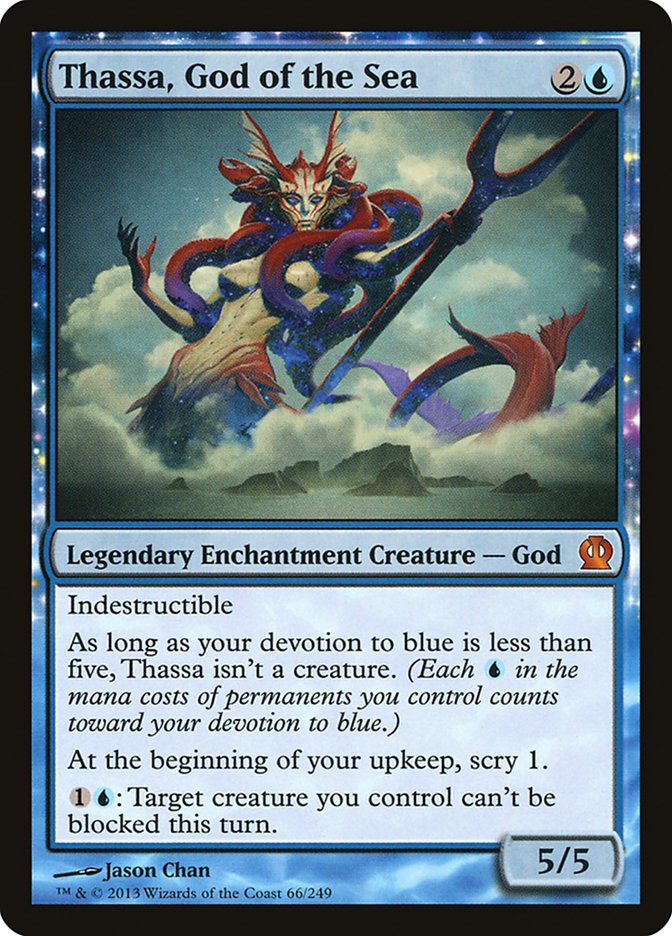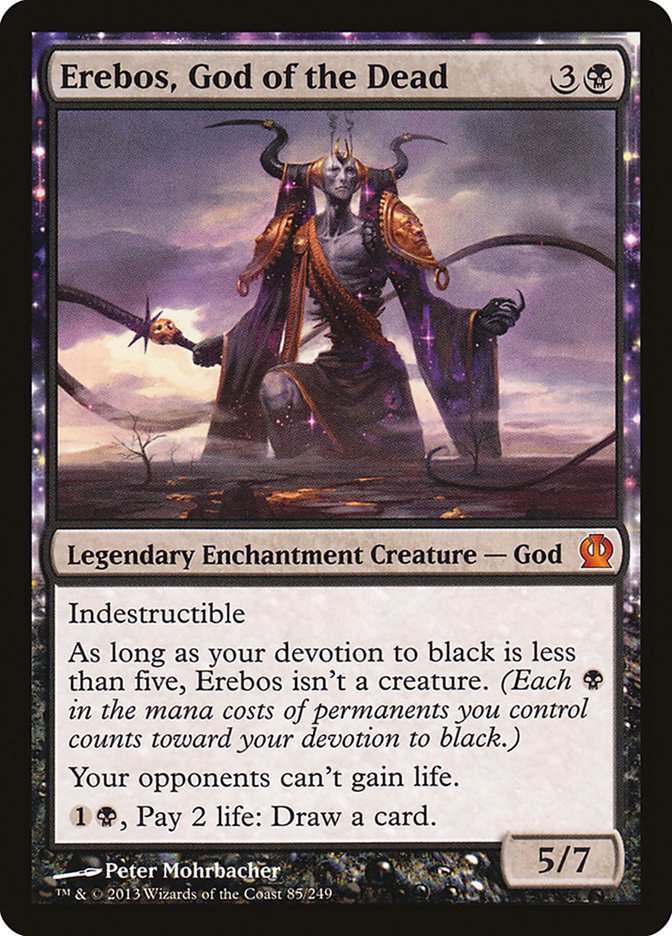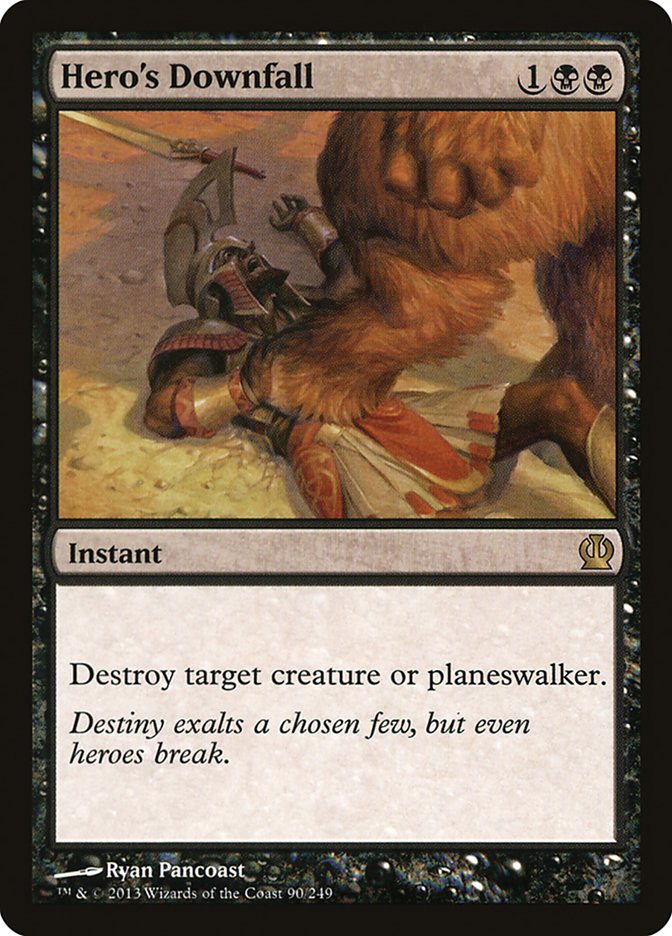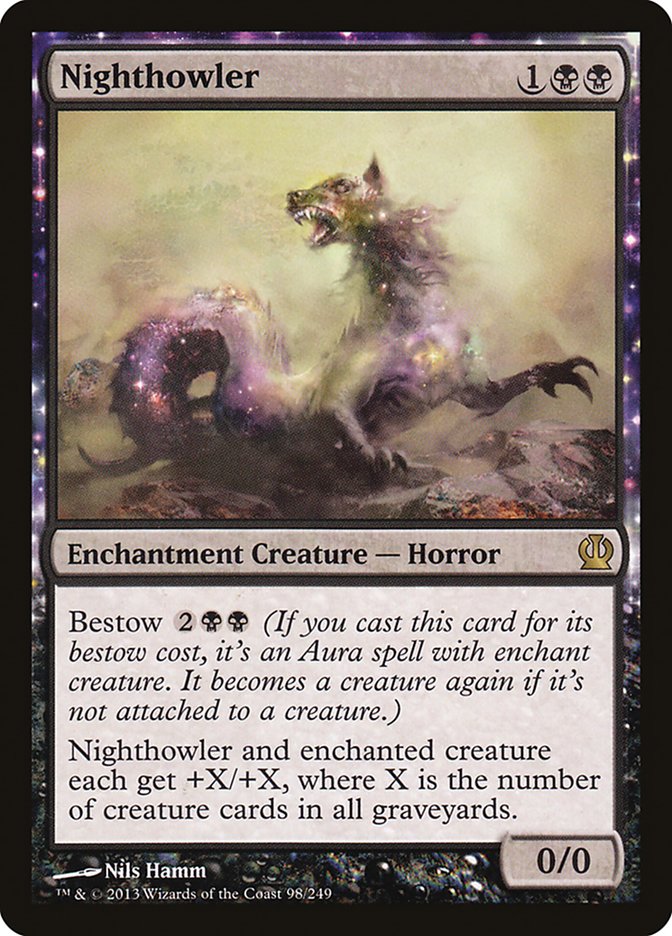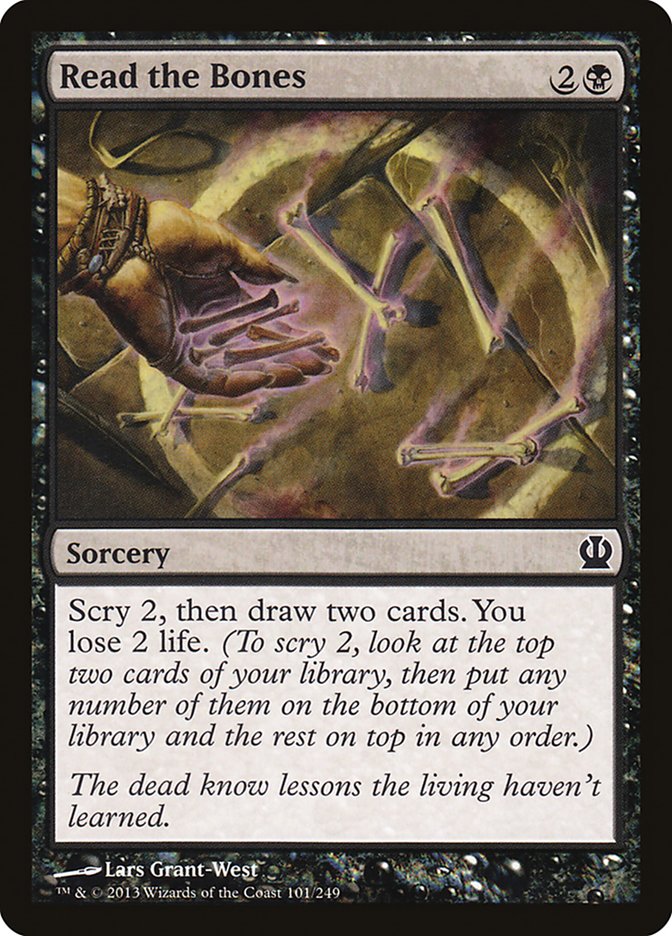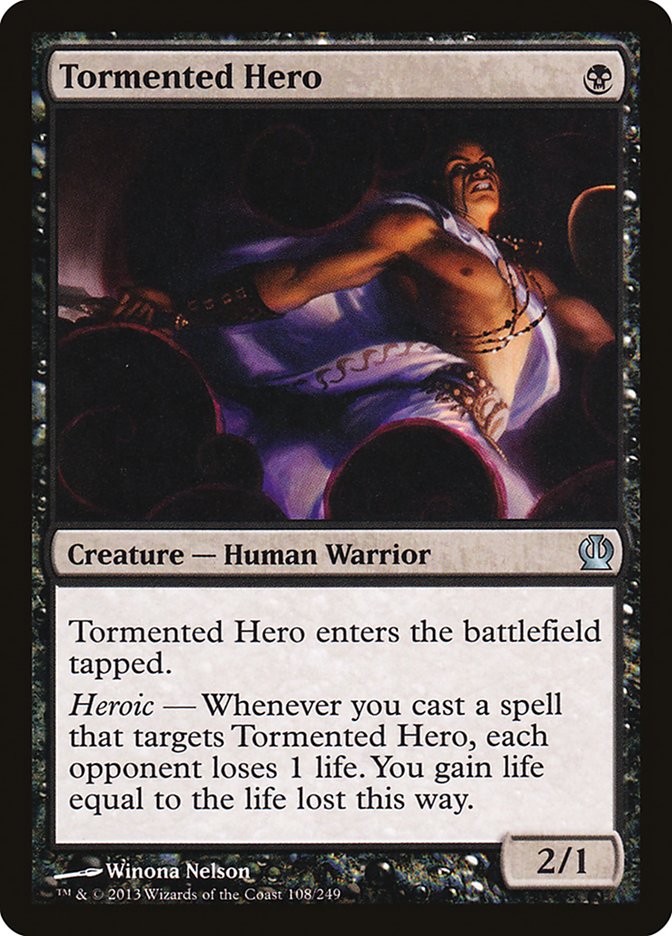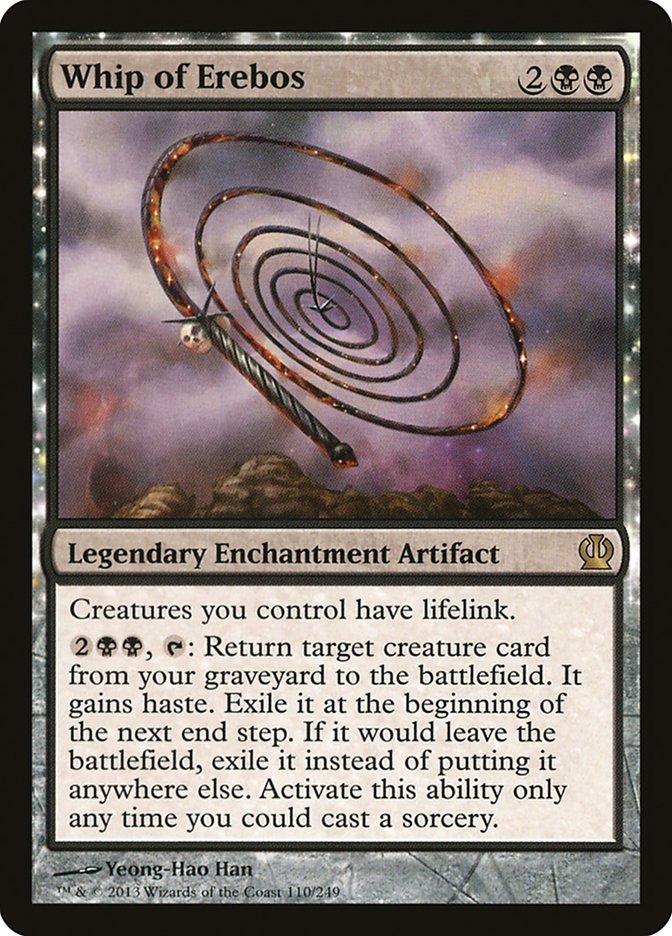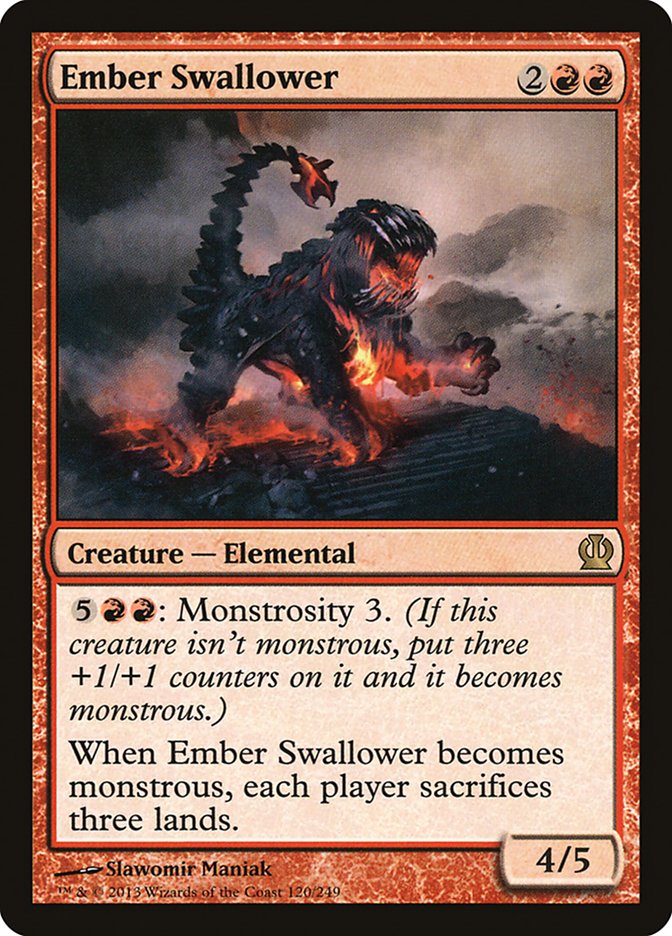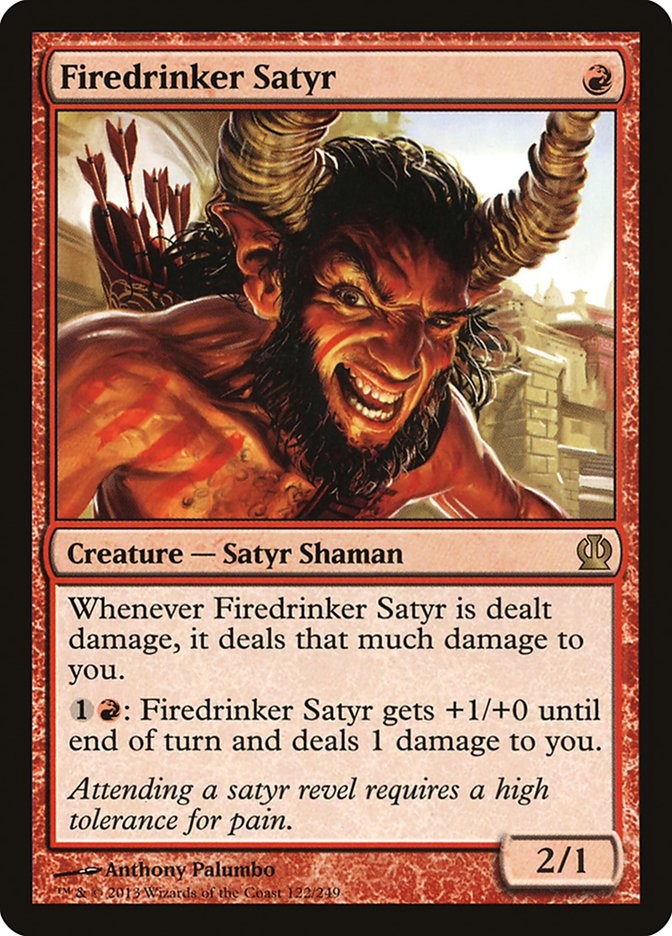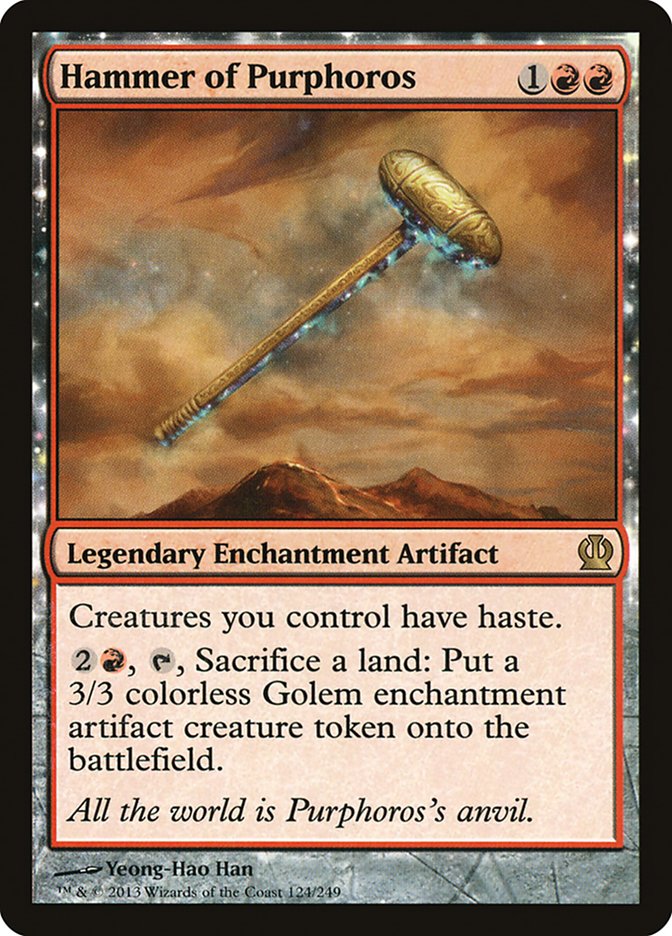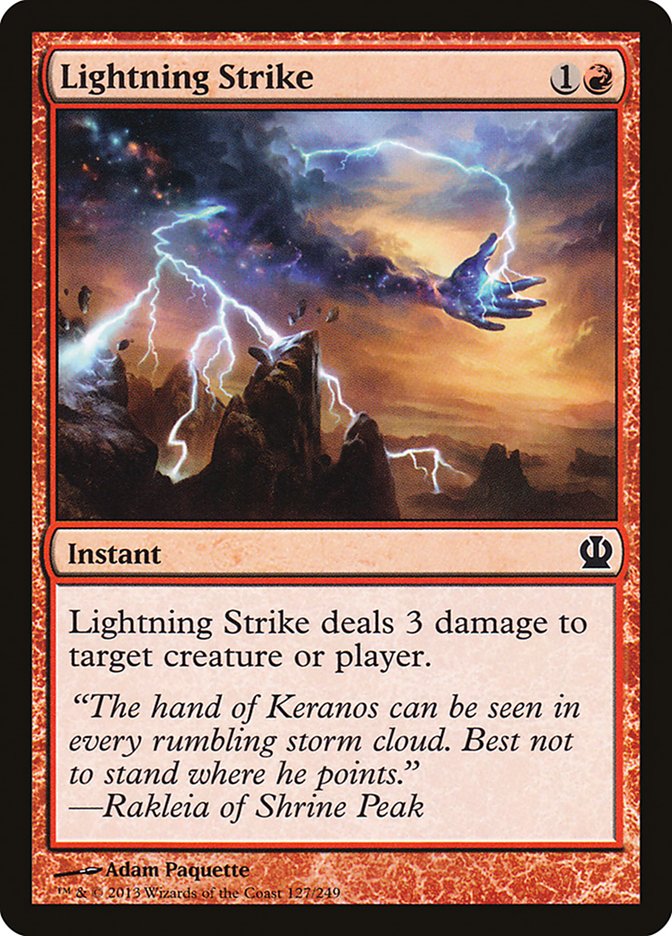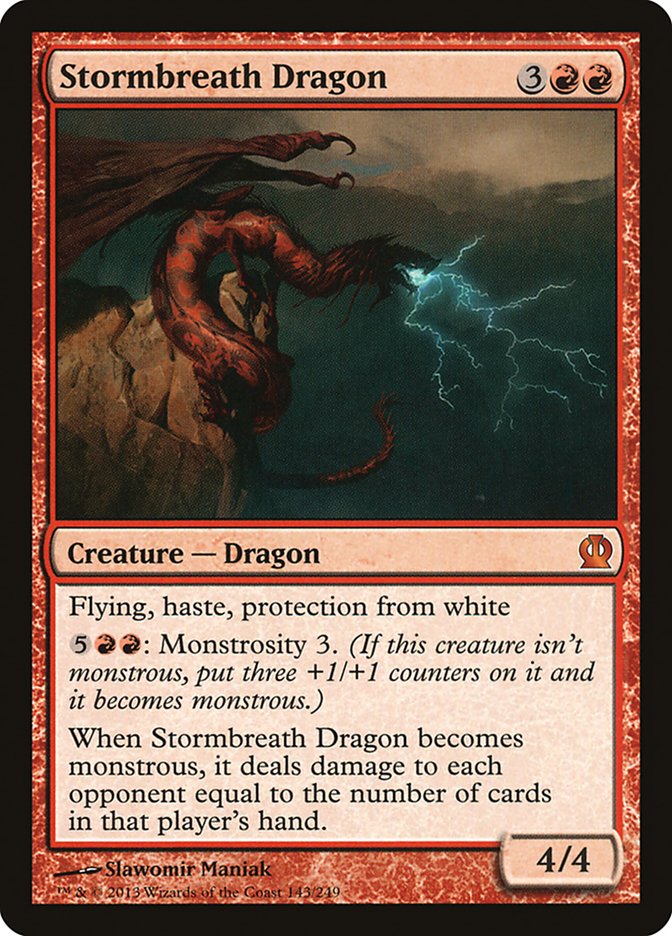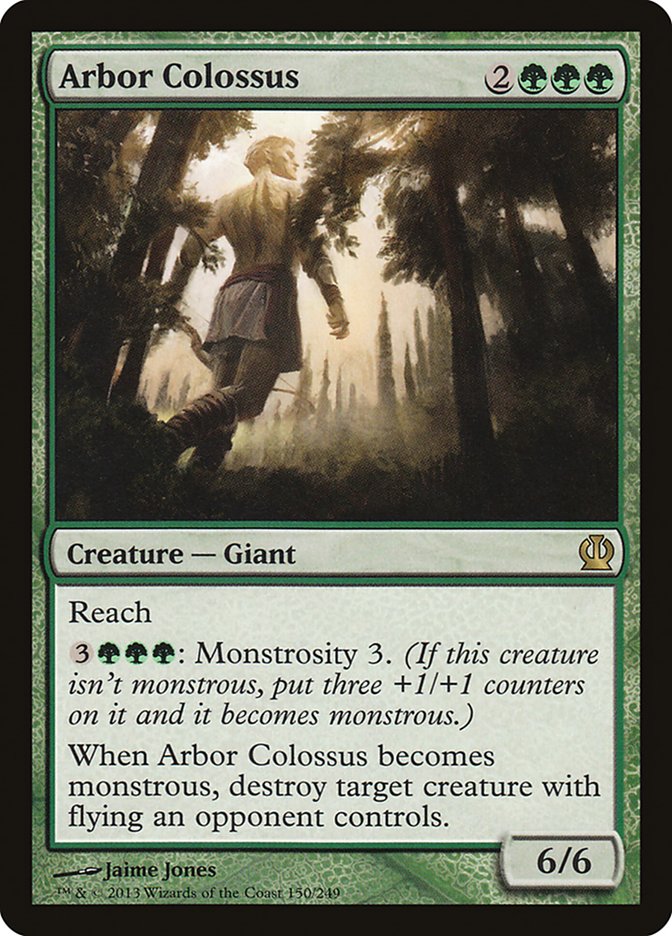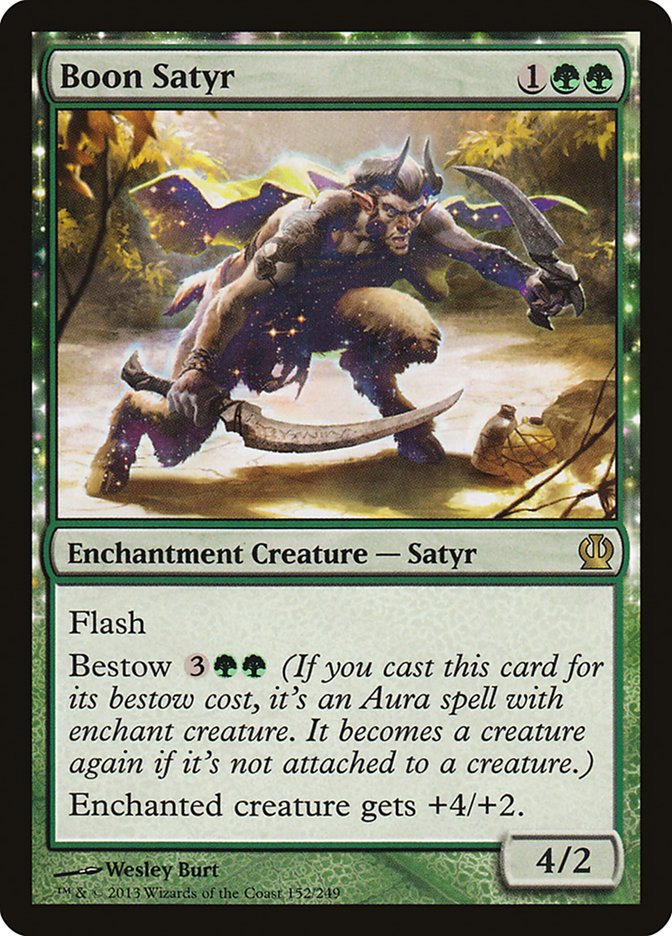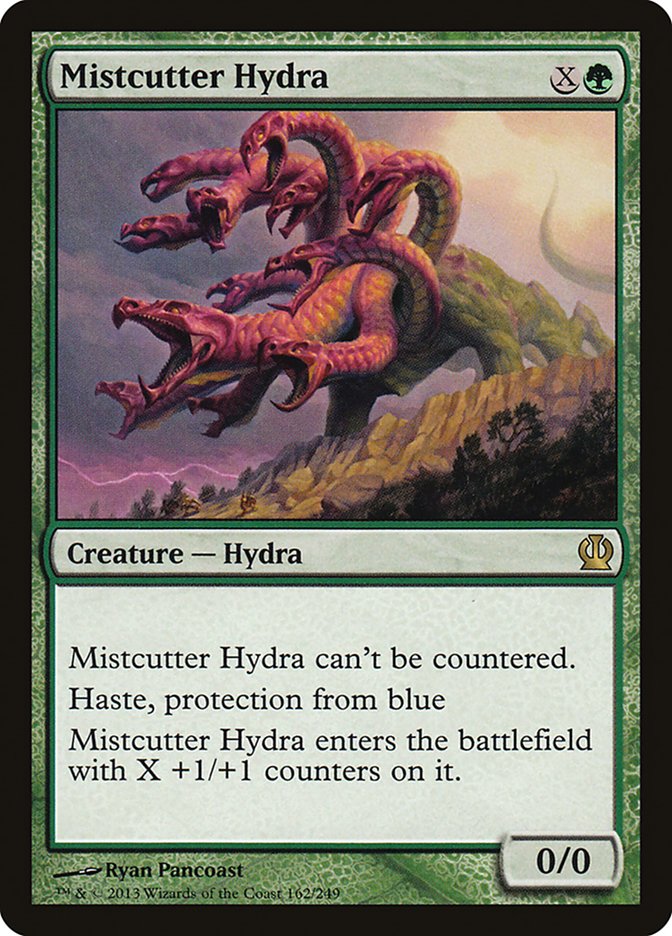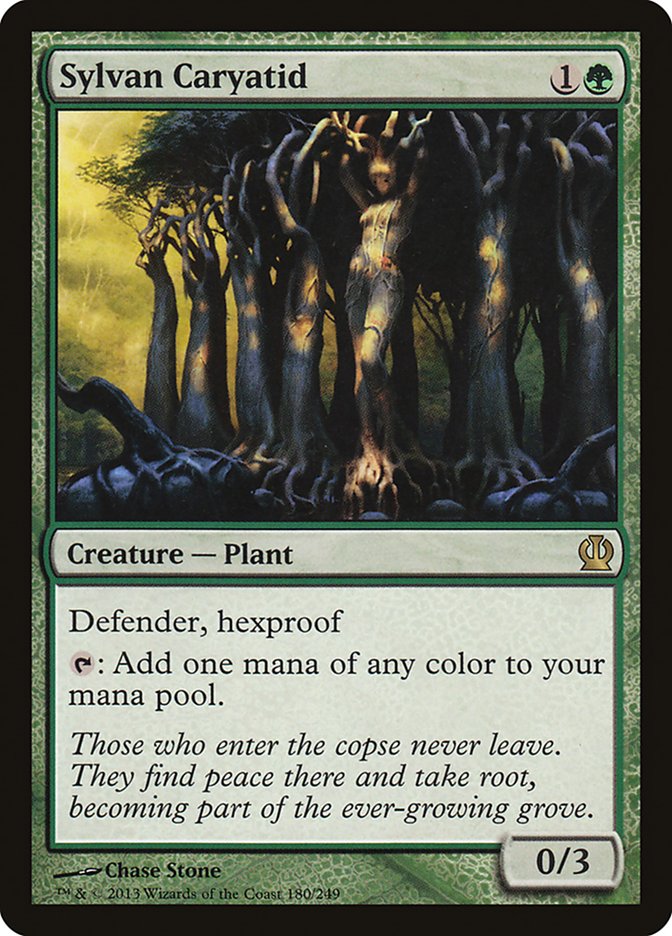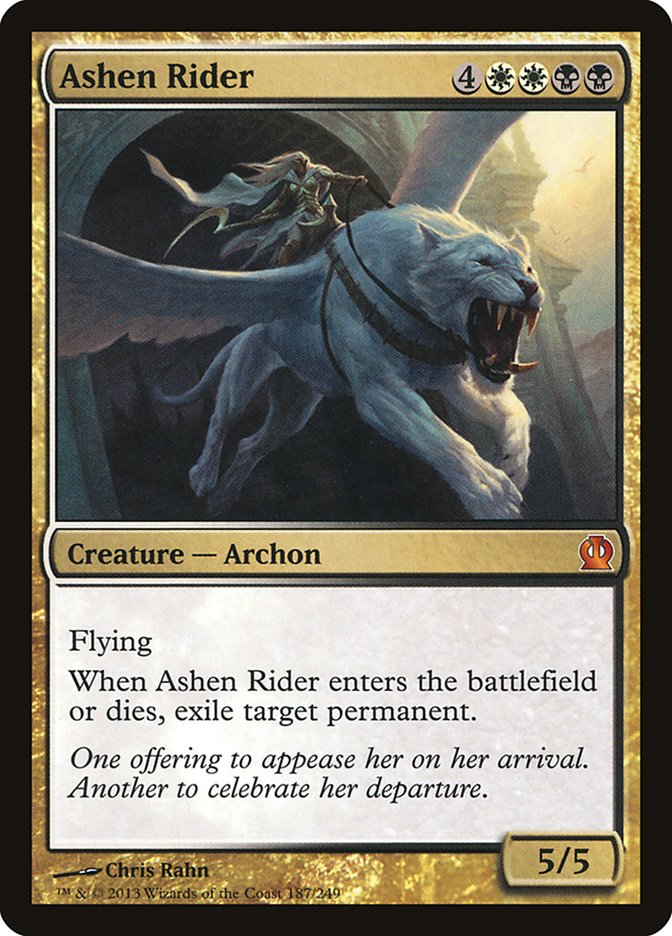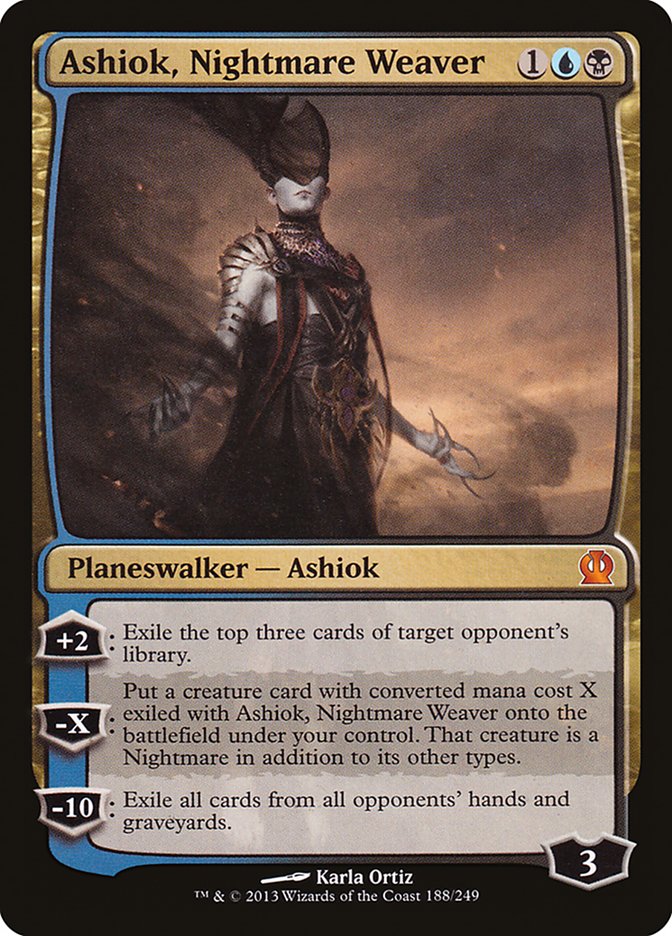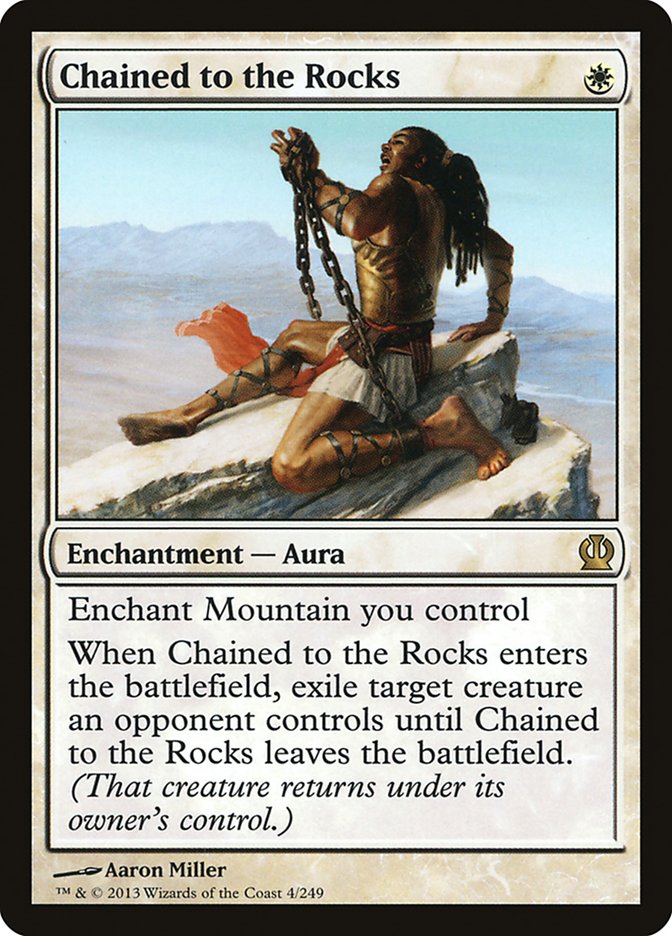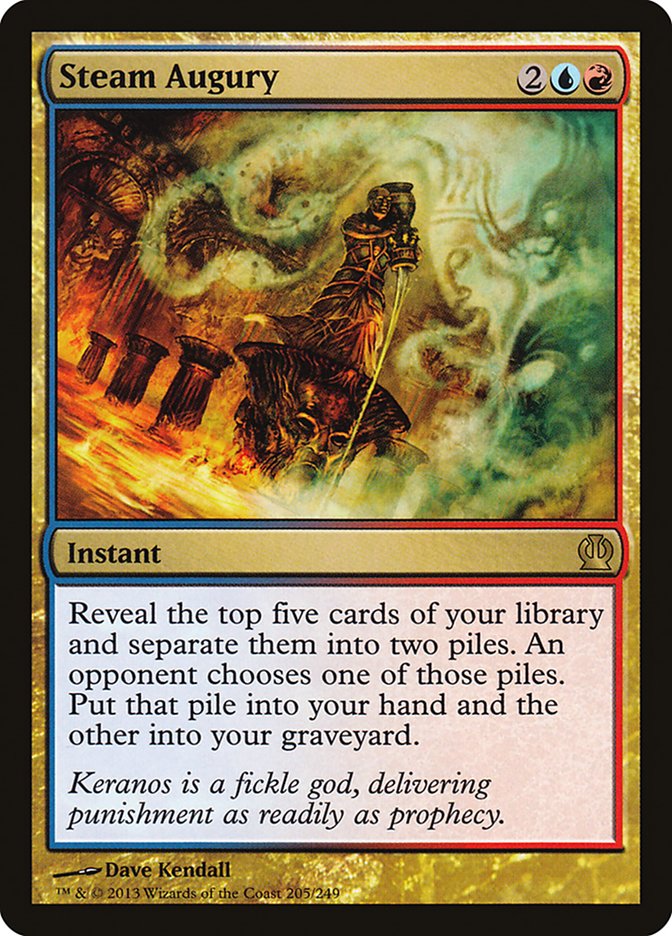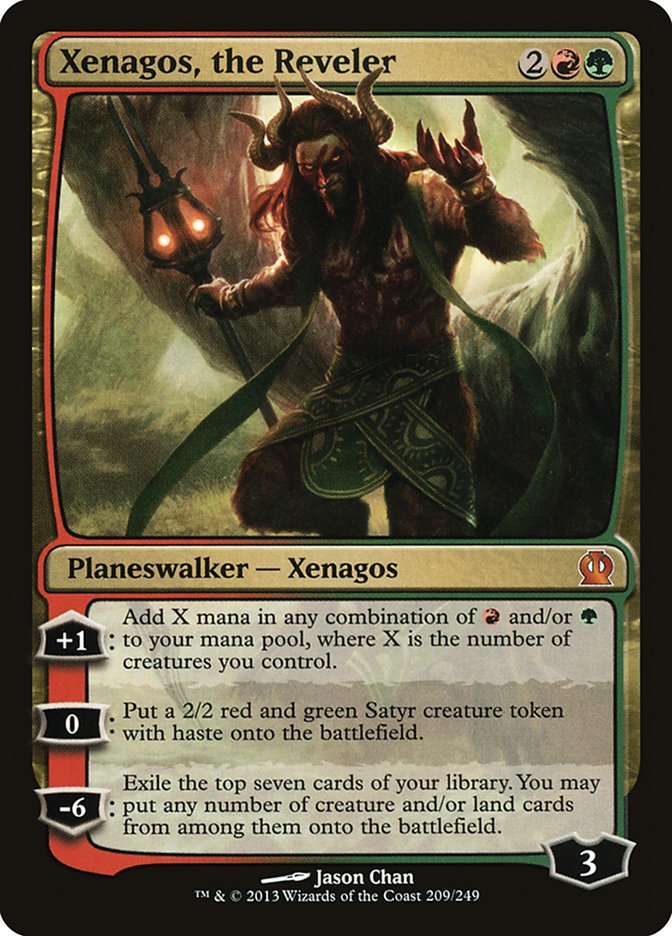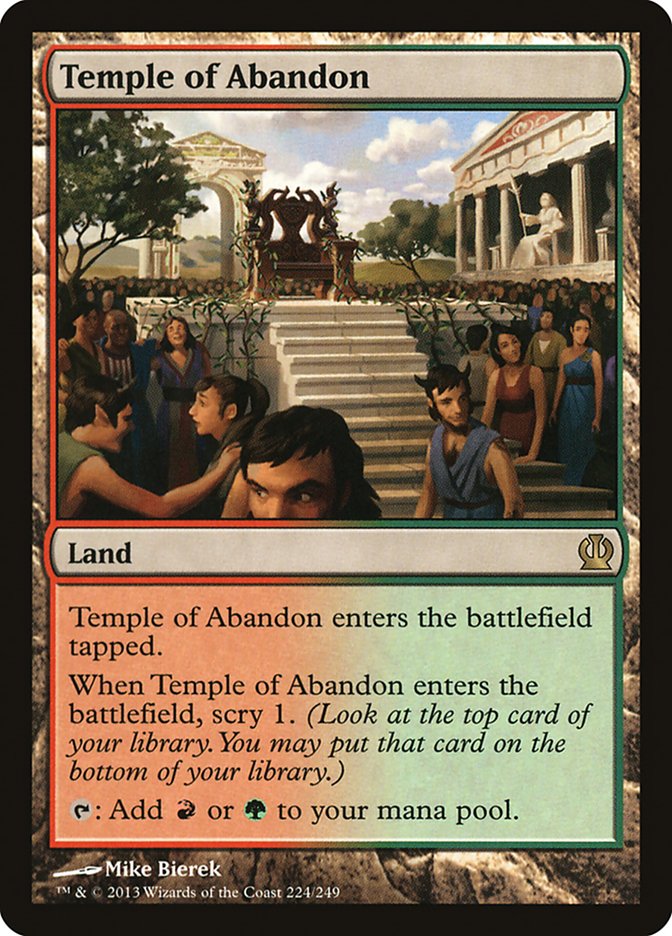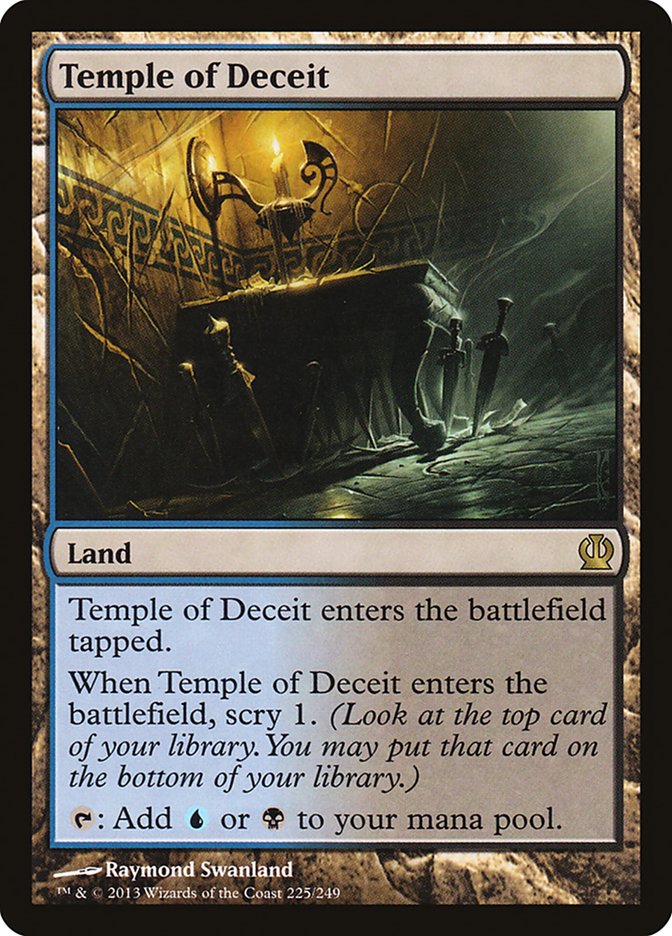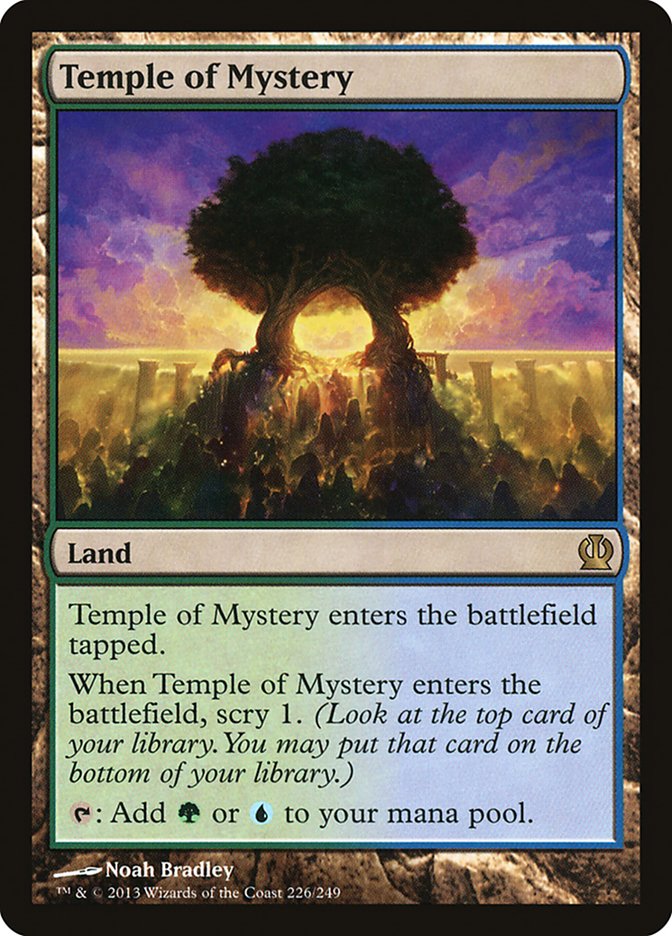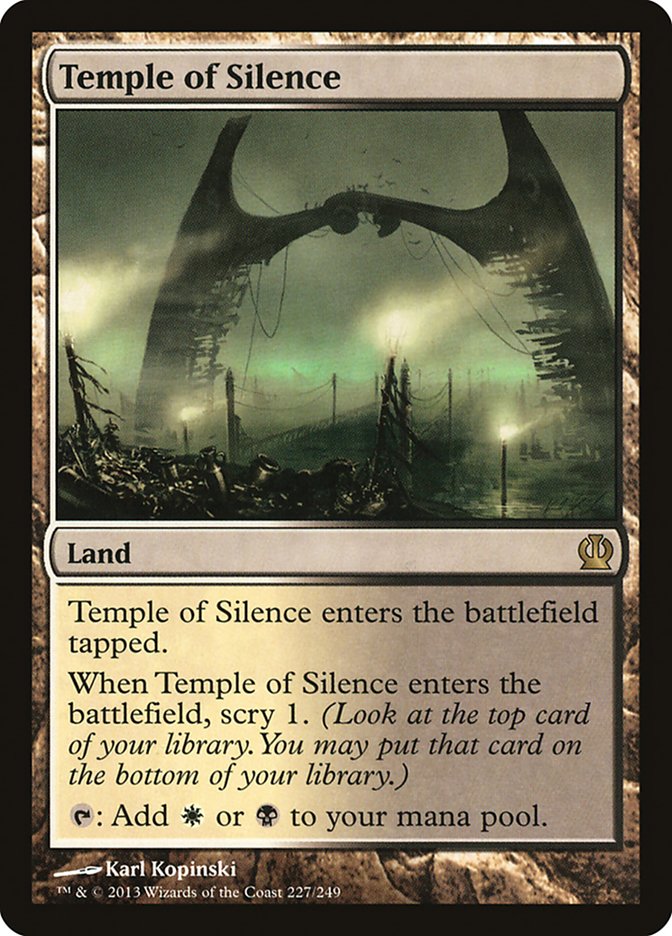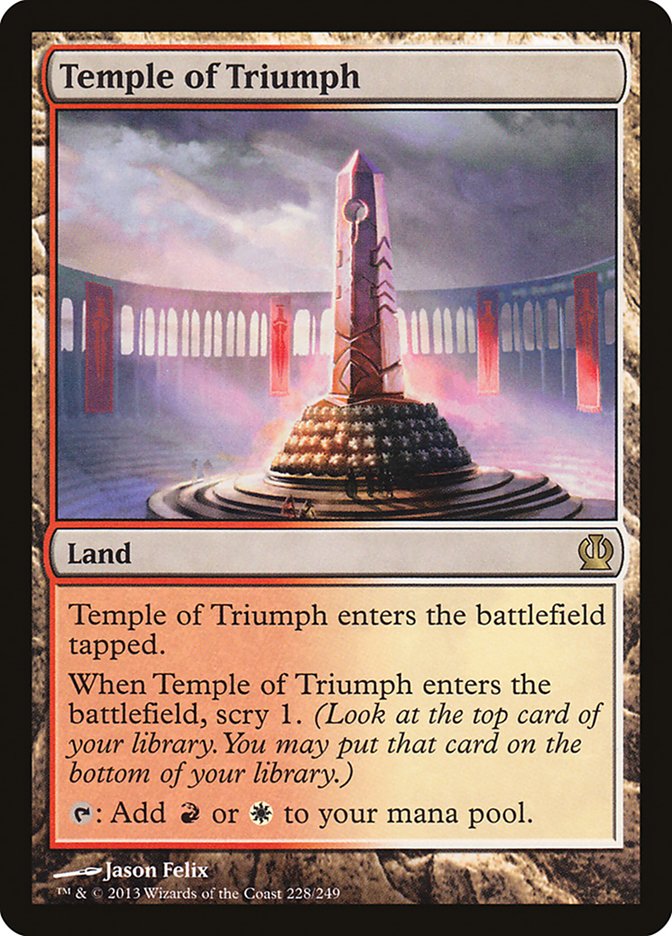With Theros about to be released, it’s time to consider it in the context of Cube.
White
Elspeth, Sun’s Champion – When the new Elspeth was revealed at the PAX party, reactions on social media sites were lukewarm, and many people weren’t really on board with it due to its six-mana cost. We haven’t seen a six-mana planeswalkers outside of Garruk, Caller of Beasts, who has had a slow adoption rate in Cube, and as such people weren’t too thrilled with it. A lot of planeswalkers have middle abilities that emulate spells, and while ones like Liliana of the Veil are A-ok to cast as a Cruel Edict +1 loyalty planeswalker, the new Elspeth’s Retribution of the Meek ability looks worse by comparison.
However, the key when looking at this solid planeswalker is noting that its combination of abilities protect it from most creatures in Cube aside from a few that can survive her sweeper-like ability such as Spirit/Illusion tokens, Vendilion Clique, Restoration Angel, and small shadow/flying creatures.Because of this, she defends herself well and typically requires being dealt with quickly since her +1 ability can emulate the pressure that gets put on a player once a card like Assemble the Legion goes active (without haste, of course) and get out of hand very quickly, which makes her a solid white finisher.
Including her in place of Elspeth Tirel is fine, but there may be other cuts lurking in your Cube. If I were still running cards like Yosei, the Morning Star or Martial Coup, I’d make that trade.
Gift of Immortality – Requiring three mana for an Aura with no board impact is pretty awkward, but it can work to protect a win condition and when combined with a creature with an enters the battlefield creature, it can make for a "deal with this or lose" situation. Admittedly, I haven’t had much of a chance to test Gift of Immortality very much, but the stars aligning for having the Aura and a permanent worth enchanting were pretty slim. In my 460-card Cube, I don’t see myself having room to run it, but I could in theory see this in larger lists.
Heliod, God of the Sun – The first of the God cycle is on the underwhelming side. It’s a known fact that four-mana white cards are extremely competitive, and Heliod doesn’t compare very well. The role of WW cards in white aggro decks has been diminished in recent years, and regardless it’s too mana-intensive at 2WW to make a 2/1 even if the tokens have vigilance. The mana intensity makes it too expensive for non-aggressive decks as well, so I don’t think this will do much in Cube.
Soldier of the Pantheon – A few years ago, I wrote an article about the idea of "kaizen" in Cube and how approaching your Cube with that ideology can help to improve your Cube by looking not just for easy upgrades when searching for how to improve your Cube but instead looking at all of the cards in your Cube. For Soldier of the Pantheon, don’t just go for the "easy upgrade" by replacing something like Elite Vanguard with it.
One-drops have been the bread and butter of aggro decks, from Powered Cubes down to Pauper Cubes, and having more is always welcome to support those decks and ensure that they have a critical mass of early creatures for strong starts.
I’m looking forward to the day when I can take cards like Elite Vanguard out of my Cube, but because I’m supporting aggressive decks, today is not that day. The multicolor hosing ability is nice, but I haven’t seen it gain very much life in my Cube (a few life per match), though it doesn’t cost you anything and is almost pure upside. Either way, it’s an easy inclusion.
Spear of Heliod – One of the things that I’ve found about noncreature spells in aggro decks in Cube is that they need to do heavy lifting since the noncreature spells are at a premium, and as such I’ve found myself cutting anthems from my Cube because they lose out in the numbers race.
Spear of Heliod trades a drawback of being killed by artifact hate with an Avenging Arrow ability. A problem that I have with that ability is that it doesn’t really do anything for what aggressive decks want—it’s a nice bonus ability to help you in racing situations, which will manifest itself more often in midrangey white decks that utilize cards like Cloudgoat Ranger; Elspeth, Sun’s Champion; and Deranged Hermit.
In this set, we’ve seen some more token support, and cards like this, the new Elspeth, and a few others like Hammer of Purphoros (and Purphoros himself) can help to create support for midrange token archetypes. If we see a few more cards of that nature, that type of archetype can be much stronger, and Spear of Heliod is a strong contender for those decks. Unlike something like Soldier of the Pantheon, it isn’t an easy inclusion since the raw stats on it aren’t as powerful, but it’s a nice tool to have if you’re looking to bolster token decks.
Blue
Curse of the Swine – A lot of cards that downgrade threats like Ixidron, Crib Swap, Gilded Drake, and Beast Within have been waning in Cubes, with Beast Within being the most represented—mainly because it deals with any permanent, not just creatures.
In theory, Curse of the Swine helps control decks deal with opposing large creatures when you have creatures that can profitably block 2/2s when the opposing large creatures are the only permanents that matter, but I’ve found that with a lot of the "downgrade" cards, the drawback of giving an opponent a creature is still a significant drawback. Sorcery speed is the final nail in the coffin, as it seems like a poor way to use your mana on your main phase in those "big creatures matter" battles.
Dissolve – I’ve never been a fan of Dissipate for Cube since the exile on it ends up being a mostly marginal upside that doesn’t make up for the extra mana in the cost because it isn’t relevant very often. The scry 1 upside on this is a better upside than the exile on Dissipate, but I’m honestly not very big on either for Cube. It could be played in larger lists that have already used the counterspells that are frequently on the outside looking in like Spell Pierce in Cube.
Master of Waves – As was discussed earlier, there has been a recent surge in popularity of recursive/sacrifice decks that use cards like Goblin Bombardment and Carrion Feeder along with token generators and creatures that recur themselves. Still, Master of the Waves is fragile, and it taking your tokens with it is very awkward, especially if you plan on using the tokens as sacrifice fodder for cards that haven’t come online yet (your 1/1 Soldier tokens may not be doing much in a world of 3/3s, but they’re at least able to stay on the board until you draw an Opposition or Greater Gargadon).
Due to its fragility (it has pro red but still gets killed by a lot of things) and being in a competitive mana slot (four in blue), it will be hard to find justifiable reasons for playing it unless you’re going very deep for token support. Marsh Flitter it is not.
Omenspeaker – Omenspeaker is a decent roadblock to deal with aggressive decks and can serve as a maindeck answer to those decks, but it’s a bit too low impact. In blue decks, on turn 2 if I’m tapping out, I’m looking to cast a mana rock or something like a Looter il-Kor; the risk of tapping out to play Omenspeaker doesn’t seem worth it even if it can profitably block 2/1s.
Prognostic Sphinx – I actually think that Prognostic Sphinx has a shot in Cube (but not really in smaller lists) when considering the card in the context of thinking of it as a Magpie. It’s questionable to where scry 3 is power-wise in comparison to drawing a card, but there’s an argument that it’s close enough to where scrying for three when it attacks (and not needing to damage an opponent) can be close, although not being able to get a benefit from it until the untap after attacking can take a peg out of the card’s sails. But the ability for it to protect itself for free is nice.
Note that since the tap part isn’t part of the cost, you can respond to multiple kill spells with its discard ability. It’s also true that while tapping it prevents it from attacking/blocking for a turn, those same talking points were used for considering Aetherling to be an unreliable blocker, which was found to not be the case. Blue five-drops are shallow enough to make this a consideration; there’s Mulldrifter and Meloku, as Morphling’s on the weak side. Presently, I’m testing it out in my Cube and wouldn’t be surprised if it doesn’t last very long, but it could find a home in larger lists looking for something to bolster the anemic five-drop slot in blue.
Thassa, God of the Sea – Repeatedly scrying one has a subtle effect on the game, and it’s something that can be hard to gauge just how useful it is. We’ve seen comparisons between Think Tank concluding that Thassa isn’t very good, but honestly Cruel Edict and Shock aren’t very good either; it’s their flexibility that makes them good. The long-term usefulness (and if you’re a blue deck, you’re probably going for the long game) of multiple scrying is useful and tapping out three mana for it on a main phase is a good use of mana even in control mirrors, as it helps sculpt future draws.
Regarding its unblockable mode, some of the better finishers are ones that can shift from defense to offense to close the game out quickly. Cards like Aetherling, Creeping Tar Pit, and Elspeth, Knight-Errant work well because they can help the deck go from defensive mode to wanting to end the game quickly. Thassa’s cheap activated ability can help other cards to shift modes quickly.
In my Cube, out of 31 permanents, seventeen have UU in their mana cost, so I found that it wasn’t as difficult to get Thassa to turn into a 5/5 as you may think, but it didn’t happen that often either (if it happened more than once a match, it was surprising). The overall package was solid enough for it to earn a slot in my Cube—at least for now.
Black
Erebos, God of the Dead – While Erebos has potential in formats like Commander, it’s way too slow for Cube. Its "can’t gain life" clause can be useful, but it and the expensive greed mode aren’t worth a card; I’d rather just Cube with Graveborn Muse or one of the four-mana flying 6/6s.
Hero’s Downfall – There have been a few black removal spells like Putrefy and Mortify that for three mana kill a creature or a different troublesome permanent. Hero’s Downfall seems to be the mono-black version. I’m actually less enthusiastic about this card than most people since a lot of the time it’s going to kill a creature. Mana cost aside, it’s better than Mortify since the ability to hit planeswalkers is better than hitting enchantments, but my initial impression in testing is that it almost always kills a creature.
Granted, I’m happy that black is getting more answers to planeswalkers because it previously just had Vampire Hexmage on color. Having this tool available for black decks to fight creatures outside of combat is very nice; it’s a card that I’m keeping a close eye on in my Cube to see how often it’s killing planeswalkers and how much it’s worth it. So far, it is.
Nighthowler – Bonehoard ended up too weak for Cubes due to inconsistency issues of its best use being in the mid-to-late game, which is odd because Nighthowler is more aggressively costed on both the hard cast mode and on the bestow mode. It has some potential, but it looks to be too inconsistent.
Read the Bones – For regular Cubes, Read the Bones will be crowded out by cards like Sign in Blood and Night’s Whisper (the latter of which has been making its way out of a lot of Cubes) due to the third mana; since it’s arguable if the scry 2 is worth one more mana, I’d say no.
Tormented Hero – Tormented Hero is worse than Diregraf Ghoul due to its one toughness and Human creature type, which has been supported less than Zombie, and since the heroic ability is essentially flavor text. Unlike with Soldier of the Pantheon and Firedrinker Satyr, it’s a downgrade on existing options, but the same adage remains—unless you’re not supporting black aggressive decks, having another 2/x for one is a good thing to add to your Cube. Its inclusion in your Cube therefore is solely dependent on whether you support black aggro or not.
Whip of Erebos – Whip of Erebos is less of a pure reanimator card since it is a value midrange card. Think of cards like Diabolic Servitude rather than cards like Reanimate, which take advantage of your big dudes dying rather than making the sole focus of your deck to reanimate a giant guy into play in the early stages of the game. As a lot of black midrange decks have enters the battlefield trigger creatures, it’ll be a nice addition to those decks because their lasting legacy will likely pay for the four mana and the life gain will likely help to swing a race.
That said, don’t be fooled into thinking that this will be a good card to put into your black aggro decks to help offset the life loss of your Carnophage and Sarcomancy because while technically it does, the Whip isn’t what you want your black aggro decks to be doing on turn 4 since you want your plays to be something with a high board impact that will help you to close out a game. It’s a solid card for black midrange and control decks and can help make up for the fact that a lot of the sweeper effects in black that aren’t called Damnation aren’t very good, helping those decks attack from another angle.
Red
Ember Swallower – While Ember Swallower doesn’t deal damage to creatures, it’s a supplemental creature to Wildfire decks since it survives Wildfire / Burning of Xinye and helps to destroy lands. However, it’s a four-drop that doesn’t immediately impact the board, which a lot of four-drops do, although those are geared towards aggressive decks. It taking a while for it to go monstrous does give an opponent a while to prepare for losing lands, though it does put the impetus on your opponent for either putting something big into play or having to deal with your 7/8 with a land handicap.
It’s a nice addition to the slower red board impact decks, but a question that you will need to ask yourself as a Cube designer with Ember Swallower and a few other red cards is how many slots you want to devote to non-aggro red decks (ultimately, the answer to that lies with you and how much support you want to give).
Firedrinker Satyr – I found that the second ability on the Satyr is pretty expensive given how much use you want to get out of your mana in red aggro decks, but its ability does work for the threat of activation factor and an on board trick for killing an opponent. That said, like the multicolor hosing on Soldier of the Pantheon, its inclusion doesn’t cost you any resources to have the ability on the card, and it’s yet another solid addition for red aggro decks.
Hammer of Purphoros – Like Ember Swallower, Hammer of Purphoros is another card for non-aggro red decks as a card to make big dumb creatures attack quicker, similarly to how Fires of Yavimaya helped make 5/5 creatures hasty back in the day. The second red mana is a bit awkward, but the ability to trade resources and have 3/3 hasters more than makes up for it by helping to supplement your threats or act as chump blockers in a pinch. A case can be made that it works better with the "Big Red" game plan than Ember Swallower, but either way the same statement of how many non-aggro cards in red you want to run applies here as well.
Lightning Strike – It’s a "boring" red burn spell that deals three. Smaller Cubes will have problems fitting in Searing Spear, Incinerate, and Lightning Strike, but most Cubes should have an easy time playing all three.
Forge[/author]“]Purphoros, God of the [author name="Forge"]Forge[/author] – The God of the Forge may end up being a monster in a few blocks if red tokens gets some more support; as of right now, it doesn’t have the immediate board impact that red aggro decks typically look for at four mana, but it can provide a ton of supplemental damage for subsequent turns. I’ve been a fan of it in slower red decks like Naya and Jund that use creatures as part of their game plan of extracting value through two-for-ones (Titans, Wall of Blossoms / Wall of Roots, etc.), but I’ve seen it work when sided in against removal and sweeper-heavy decks as a way to extract value out of topdecked creatures.
I’m happier with Thassa in Cube, but like Hero’s Downfall, Purphoros is a card that I’m keeping an eye on since the raw potential is very high on it because it has a ton of damage potential. If it doesn’t work in Cubes at the moment, it may just take a bit more support for tokens for it to become a build around.
Stormbreath Dragon – Stormbreath Dragon is a card that will end up getting outmuscled of many Cubes because of the competition; red fives aren’t as competitive as white or red fours, but it’s hard to include this alongside Zealous Conscripts, Siege-Gang Commander, and Thundermaw Hellkite. Protection from white is useful to blank removal (although white is the color of sweepers if it needs to take that measure to kill it), but the instant speed monstrous ability can make it so that the opponent at least gets domed for one on their draw step (if they didn’t draw an instant). We may just be spoiled by Thundermaw, but Stormbreath is a card that will likely be on the outside looking in.
Green
Arbor Colossus – Back in my day we had Orgg. Now we have this. I prefer cards like Kalonian Hydra and Baneslayer for the "big dumb idiot that has to be dealt with now or you will be taking a lot of damage" kind of thing, as those have enormous upsides if they live. This at least does monstrous on curve, which few do.
Boon Satyr – Two toughness is awkward, and it’s part of why cards like Troll Ascetic have been finding their way out of Cubes, as the Troll almost always needs to regenerate when it gets into a fight. Green’s three-drops have been on the weak side, and few of them really work well for aggressive strategies. Unlike something like Wolfir Avenger, it will likely trade with whatever it fights, but on an empty board, it can fight planeswalkers very well assuming that the opponent doesn’t have blockers for it. The bestow cost is actually pretty fairly costed for getting lots of damage out of nowhere and helping 2/2s trade with Titans.
Bow of Nylea – The Bow is a lot like Staff of Domination, Trading Post, and Obelisk of Alara that used to be regarded highly but went by the wayside due to their lack of immediate board impact and being slow. However, the deathtouch is a useful static effect that works well with mana dorks and tramplers, and the 1G ability does a lot of little things.
The only ability that I found isn’t very good is dealing two to a flying creature since most of the creatures that the Bow can kill are typically only half/a third of a card (Hornet Queen / Lingering Souls tokens) and the others aren’t very high in number (Chandra’s Phoenix / Vendilion Clique, creatures like Mistral Charger that have low adoption rates), but the other abilities are all solid. Even the putting cards from the graveyard into the library work well with creature tutors in green like Green Sun’s Zenith and Natural Order. All in all, it’s a decent addition for green decks but by no means a staple.
Mistcutter Hydra – Historically X spells are underrated, but admittedly not many have made it into Cube aside from Earthquake style effects, Entreat the Angels, and Profane Command. This is because it looks weak at each part of the mana curve (which Evan and Brad talked about in their Theros review); the flexibility tends to be underrated since it’s harder to quantify than just pure direct comparisons. With that in mind, even with haste it doesn’t feel like Mistcutter Hydra has enough of a board impact at any mode, but it can close out a game quickly if in topdeck mode. It’s a weapon for fighting blue decks, but it ultimately falls flat.
Polukranos, World Eater – Polukranos’ spoiler journey went through it being thought of as going monstrous as XGG that fights any number of creatures to being a XXG that deals damage equal to its counters to all creatures and back and eventually settling on the "worst" iteration of it going monstrous as a XXG that deals damage equal to creatures divided as you chose. It reminded me of the debate about whether Giant Solifuge was a 4/1 or a 4/3, which went on before Guildpact was released based on blurry scans:


When people found out about it being a 4/1 instead of a 4/3, they ended up disappointed since their hopes were made high by the 4/3. When people found that Polukranos was the worst iteration of all of the rumored modes, they compared it to another 2GG 5/5, Deadbridge Goliath, and were disappointed since Deadbridge hasn’t really done much in Cube. As it turns out, a 4/3 Giant Solifuge would have been absurd, and a 4/1 was still very good; a XGG Monstrous Polukranos would have been absurd, and a XXG is still very good in Cube.
In addition to its very solid base stats, it deals with small chump blockers that would normally annoyingly get in the way of large creatures like it, and once it goes monstrous, it should be able to survive fights with just about every creature in Cube. It also has other subtle effects like deterring an opponent from equipping a creature. There aren’t many options for green removal outside of Master of the Wild Hunt, and that combined with efficient stats have made it a solid addition to my Cube.
Sylvan Caryatid – Much like with how Spear of Heliod has its own upsides and downsides from Glorious Anthem, so does Sylvan Caryatid from cards like Rampant Growth and Farseek. I haven’t really been a fan of the latter cards in Cube because I’ve found that they are not very efficient mana fixers/accelerants, especially when compared to artifact mana, but I have been happy with Sylvan Caryatid. It has the drawback of being vulnerable to sweepers and edicts, but it provides the upsides of being able to tap for any mana and blocking, which more than make up for it. It’s worse than the one-mana green elves and it’s debatable whether it’s worse than Wall of Roots, but it’s a nice addition to green ramp and midrange decks.
Miscellaneous
Ashen Rider – If you’re running Angel of Despair, this is actually an "easy upgrade" because there isn’t really room for two of these types of effects in an Orzhov section of a Cube and while it costs an additional mana, it usually just gets reanimated.
Ashiok, Nightmare Weaver – Ashiok can’t defend itself quickly, but it can ride the value wave, especially versus aggressive decks. It can be awkward when battling it and having to choose between attacking it or your opponent when you’re the aggressive deck and a one- or two-drop gets milled, but its minimal board impact until it reanimates something is a strike against it. It has been pretty good in testing so far, and while I would recommend it, I wouldn’t place it above stalwarts like Baleful Strix.
Chained to the Rocks – When playing aggressive decks, I want to use my mana as efficiently as possible. Unless I have a Plateau, I can’t cast it on turn 1, but I found that it wasn’t that big of a deal anyway since I usually wanted to kill big reanimated things or annoying blockers later than turn 1 (although not being able to spike an early Birds/Bob is annoying). The drawback of it being tied to a land isn’t a big deal, although it can be awkward as a nombo with Armageddon effects, but it isn’t big enough for me to dislike it.
Steam Augury – While Steam Augury is no Fact or Fiction since the opponent chooses, you typically get value out of casting it. You can’t make it so that it acts like a miser’s Impulse by getting the four-one bad-good card split, but most of the value of acting like a solid draw spell is intact, and I’ve been a fan of it in red decks splashing blue for it. Since the opponent will not have perfect information, they may not be able to accurately deduce which is the better pile. Izzet has a cadre of cards like Ral Zarek, Prophetic Bolt, Izzet Charm, and Fire // Ice, and Steam Augury fits well amongst them.
Xenagos, the Reveler – While it’s annoying that Gruul keeps getting 2RG planeswalkers, Xenagos rumbles with the best of them by being able to continually spam 2/2 hasters. The +1 ability is ho-hum in aggro decks since they typically don’t need a ton of mana unless there are mana sinks and therefore is more at home in R/G ramp. However, even if Xenagos is a one-mana planeswalker in aggressive decks, do you know what other one-ability planeswalker has also been an all-star for Cube aggro decks?
Nuff said.
The ability to continually spam 2/2s with haste allows it to threaten planeswalkers and opponents with low defenses very quickly and provides a nice option for aggressive decks to push pressure with sustainable threats. I’d rank Xenagos behind Bloodbraid Elf because that card is just dumb, but aside from that and arguably Huntmaster of the Fells, I’d rank this as my third for Gruul. Smaller Cubes may have a hard time including Xenagos due to limited slots, but it’s a very powerful card worth including if possible.
Temple Cycle – The Temple cycle is yet another cycle of ETB tapped lands that can be awkward for aggro if not properly balanced; the effect is useful enough to be solid for most decks, but it is in the middle ground for mana fixing lands. If you’re running complete cycles of lands, there likely isn’t room for all of the Temple lands. But if you’re running partial cycles in your Cube, the Temple cycle can help to supplement some of the weaker color pairs like Izzet and Simic.
I hope that this article has given you some insight into what Theros offers for your Cube; it’s a powerful set that provides a lot of options for Cube designers to customize and tinker with our Cubes.
May all of your opening packs contain Sol Rings!
@UsmanTheRad on Twitter
My blog featuring my Powered and Pauper Cube lists: I’d Rather Be Cubing
Cube podcast that I and Anthony Avitollo co-host: The Third Power


